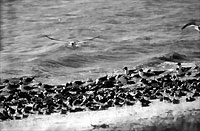|
Lucky Break for Horseshoe Crabs
By Kim Todd
 The desire to help horseshoe crabs comes early. The ancient creatures, more closely related to spiders than crabs and lugging helmet-shaped shells, often strand themselves upside-down on the beach, drawing hungry gulls and curious children. The desire to help horseshoe crabs comes early. The ancient creatures, more closely related to spiders than crabs and lugging helmet-shaped shells, often strand themselves upside-down on the beach, drawing hungry gulls and curious children.
"You come across your first one on the beach, flipped over, its legs up in the air, and of course you want to flip it back," said Tina Schvejda, chair of the New Jersey Chapter.
But recently, Schvejda and other Sierra Club members gave the species a much more substantial helping hand.
 On Feb. 5, the National Marine Fisheries Service banned horseshoe crab harvest near the mouth of Delaware Bay, an area crucial for animals coming to spawn on the bay's sandy beaches. The 1,500-square-mile Carl N. Schuster Jr. Horseshoe Crab Reserve, named after the noted horseshoe crab scientist, covers 30 nautical miles out to the ocean and stretches from south of Pecks Beach, N.J., to north of Ocean City, Md. The harvest ban took effect March 7. On Feb. 5, the National Marine Fisheries Service banned horseshoe crab harvest near the mouth of Delaware Bay, an area crucial for animals coming to spawn on the bay's sandy beaches. The 1,500-square-mile Carl N. Schuster Jr. Horseshoe Crab Reserve, named after the noted horseshoe crab scientist, covers 30 nautical miles out to the ocean and stretches from south of Pecks Beach, N.J., to north of Ocean City, Md. The harvest ban took effect March 7.
While horseshoe crab meat isn't eaten by humans, fishermen use it as bait to lure more economically desirable creatures such as eel, catfish and whelk. The medical industry also uses them for testing in pharmaceuticals and suturing. The crabs fetch 75 cents to $1 each. Increasing harvest in recent years has lead to fears that the population might crash, devastating not only the crabs, but the bay's entire ecosystem.
Horseshoe crabs come ashore on the beaches of Delaware Bay from late spring to early fall to mate and lay eggs. At the same time, other species are building nests, and hundreds of thousands of birds are migrating through, making the site the second largest staging area of the annual shorebird migration in North America.
"It's like the bay is this giant maternity ward from April to October," said Mike D'Amico, organizer for the Atlantic Coast Ecoregion.
And at the center of much of this activity is the horseshoe crab.
The crab eggs provide vital food for sanderlings, plovers and sandpipers passing through. Once the crabs mature and head out to sea, they become an important part of the diet of sharks and juvenile loggerhead sea turtles. In turn, horseshoe crabs consume clams, mussels and sandworms.
The establishment of the reserve recognizes both the crabs' important ecosystem role and the need to look at protection for different phases in its life cycle, according to D'Amico.
"The Sierra Club fought for this reserve because scientific observations were showing that juveniles and virgin adults on the open ocean were being caught in the harvest for adults - they were not getting the chance to become mature so they could reproduce," he said.
Rooting arguments in available biology, coupled with field observations, was a major part of the Club's strategy in working to get the regulation installed, according to Schvejda. Compiling a strong file of scientific facts, the New Jersey Chapter shared it with activists via the Web and listserves. That way, everyone had solid statistics to use in letters and present at public hearings.
"When you come in with the facts, that's not disputable," said Schvejda.
Another successful technique involved pairing with like-minded organizations, including the Audubon Society, the American Bird Conservancy, the World Wildlife Fund and many others, building enough support that legislators took notice. Eventually former Delaware Gov. Thomas R. Carper (D) (now a U.S. senator), Maryland Gov. Parris N. Glendening (D) and former New Jersey Gov. Christine Todd Whitman (R) (now chief of the U.S. Environmental Protection Agency) lent their support.
The new "no harvest" zone is one of a series of victories for horseshoe crabs in recent years. A year ago, the Atlantic states came together and agreed to cut the horseshoe crab harvest by 25 percent. Until recently, Virginia hadn't signed on and fishermen were cruising off the Delaware and New Jersey coasts, catching horseshoe crabs and selling them in Virginia. But even this reluctant holdout agreed to adopt a lower catch limit last October.
Fishermen who testified against the ruling at public hearings argued that the regulations were premature because not enough is known about horseshoe crabs.
D'Amico agrees with at least the second part of that statement, and said that the next steps are to push for additional studies and to protect more habitat. The fact that protection was given even while much about the horseshoe crab remains a mystery is yet another important aspect of the decision.
"It's using the precautionary principle - we're going to err on the side of conservation," D'Amico said.
Photos courtesy USGS. Home Away from Home: Hundreds of thousands of birds stop by Delaware Bay every year to feast on the horseshoe crab eggs that provide vital fuel for their migration. A new "no harvest" horseshoe crab reserve will ensure that the crabs will continue to thrive and that there will be plenty of eggs when the birds arrive.
Up to Top
|